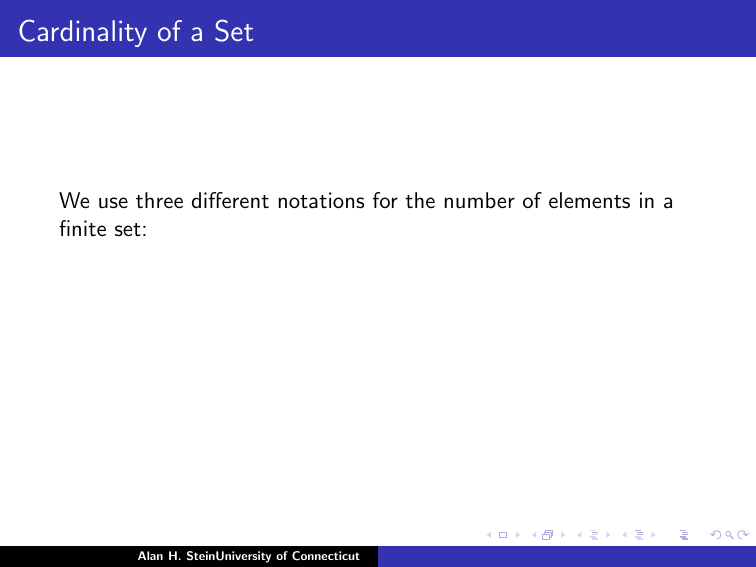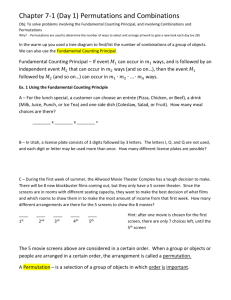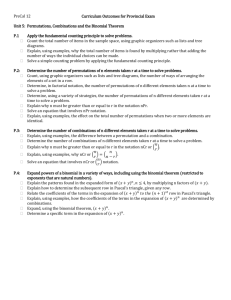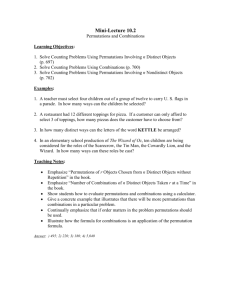Cardinality of a Set n(A) |A| #A
advertisement

Cardinality of a Set We use three different notations for the number of elements in a finite set: Alan H. SteinUniversity of Connecticut Cardinality of a Set We use three different notations for the number of elements in a finite set: I n(A) Alan H. SteinUniversity of Connecticut Cardinality of a Set We use three different notations for the number of elements in a finite set: I n(A) I |A| Alan H. SteinUniversity of Connecticut Cardinality of a Set We use three different notations for the number of elements in a finite set: I n(A) I |A| I #A Alan H. SteinUniversity of Connecticut Inclusion-Exclusion Principle Theorem (Inclusion-Exclusion Principle) |A ∪ B| = |A| + |B| − |A ∩ B| Alan H. SteinUniversity of Connecticut Inclusion-Exclusion Principle Theorem (Inclusion-Exclusion Principle) |A ∪ B| = |A| + |B| − |A ∩ B| This is almost self-evident, since if want to find the number of elements in the union and we add the number of elements in each of the two sets, we will have counted the elements in the intersection twice. Alan H. SteinUniversity of Connecticut Inclusion-Exclusion Principle Theorem (Inclusion-Exclusion Principle) |A ∪ B| = |A| + |B| − |A ∩ B| This is almost self-evident, since if want to find the number of elements in the union and we add the number of elements in each of the two sets, we will have counted the elements in the intersection twice. This is really a special case of a more general Inclusion-Exclusion Principle which may be used to find the cardinality of the union of more than two sets. Alan H. SteinUniversity of Connecticut Inclusion-Exclusion Principle Theorem (Inclusion-Exclusion Principle) |A ∪ B| = |A| + |B| − |A ∩ B| This is almost self-evident, since if want to find the number of elements in the union and we add the number of elements in each of the two sets, we will have counted the elements in the intersection twice. Fundamental Principle of Counting Theorem (Fundamental Principle of Counting) If we have to make a sequence of choices for which the first choice can be made in n1 ways, the second choice can be made in n2 ways, the third choice can be made in n3 ways, and so on, then the entire sequence of choices can be made in n1 · n2 · n3 · . . . ways. Alan H. SteinUniversity of Connecticut Fundamental Principle of Counting Theorem (Fundamental Principle of Counting) If we have to make a sequence of choices for which the first choice can be made in n1 ways, the second choice can be made in n2 ways, the third choice can be made in n3 ways, and so on, then the entire sequence of choices can be made in n1 · n2 · n3 · . . . ways. Example: There are 36 ways of rolling a pair of dice, since there are 6 ways the first die can come out and 6 ways the second can come out, so there are 6 · 6 = 36 ways the two dice can come out. Alan H. SteinUniversity of Connecticut Fundamental Principle of Counting Combinations and Permutations Definition (Combination) A combination is a subset. Alan H. SteinUniversity of Connecticut Combinations and Permutations Definition (Combination) A combination is a subset. Definition (Permutation) A permutation is a list or arrangement of elements chosen from some set. Permutations may be either with replacement or without replacement. Alan H. SteinUniversity of Connecticut Combinations and Permutations Definition (Combination) A combination is a subset. Definition (Permutation) A permutation is a list or arrangement of elements chosen from some set. Permutations may be either with replacement or without replacement. In a permutation with replacement, there may be repetitions of elements within an arrangement. Alan H. SteinUniversity of Connecticut Combinations and Permutations Definition (Combination) A combination is a subset. Definition (Permutation) A permutation is a list or arrangement of elements chosen from some set. Permutations may be either with replacement or without replacement. In a permutation with replacement, there may be repetitions of elements within an arrangement. In a permutation without replacement, no such repetitions may occur. Alan H. SteinUniversity of Connecticut Examples For example, if we shuffle a deck of cards and, one at a time, choose five cards and write down the cards we have chosen, in order, we have a permutation without replacement of length five chosen from a set of size 52. Alan H. SteinUniversity of Connecticut Examples For example, if we shuffle a deck of cards and, one at a time, choose five cards and write down the cards we have chosen, in order, we have a permutation without replacement of length five chosen from a set of size 52. On the other hand, if we choose five cards from a deck, but each time we choose a card we then put it back into the deck, so that it can be chosen again, we get a permutation with replacement of length five chosen from a set of size 52. Alan H. SteinUniversity of Connecticut Examples For example, if we shuffle a deck of cards and, one at a time, choose five cards and write down the cards we have chosen, in order, we have a permutation without replacement of length five chosen from a set of size 52. On the other hand, if we choose five cards from a deck, but each time we choose a card we then put it back into the deck, so that it can be chosen again, we get a permutation with replacement of length five chosen from a set of size 52. Permutations will generally be assumed to be without replacement unless either the context implies they are with replacement or it is specifically stated that they are with replacement. Alan H. SteinUniversity of Connecticut Examples For example, if we shuffle a deck of cards and, one at a time, choose five cards and write down the cards we have chosen, in order, we have a permutation without replacement of length five chosen from a set of size 52. On the other hand, if we choose five cards from a deck, but each time we choose a card we then put it back into the deck, so that it can be chosen again, we get a permutation with replacement of length five chosen from a set of size 52. Permutations will generally be assumed to be without replacement unless either the context implies they are with replacement or it is specifically stated that they are with replacement. Many sample spaces which generate equiprobable spaces contain either combinations or permutations of elements of other sets. Alan H. SteinUniversity of Connecticut Notation The number of combinations of size k chosen from a set of size n will be denoted by C (n, k), n Ck , Cn,k or kn . Alan H. SteinUniversity of Connecticut Notation The number of combinations of size k chosen from a set of size n will be denoted by C (n, k), n Ck , Cn,k or kn . The number of permutations (without replacement) of length k chosen from a set of n elements is denoted by P(n, k), n Pk or Pn,k . Alan H. SteinUniversity of Connecticut Notation The number of combinations of size k chosen from a set of size n will be denoted by C (n, k), n Ck , Cn,k or kn . The number of permutations (without replacement) of length k chosen from a set of n elements is denoted by P(n, k), n Pk or Pn,k . There is no special notation for the number of permutations with replacement. Alan H. SteinUniversity of Connecticut Counting Permutations With Replacement From the Fundamental Principle of Counting, Alan H. SteinUniversity of Connecticut Counting Permutations With Replacement From the Fundamental Principle of Counting, if we choose k elements from a set of size n, with replacement, Alan H. SteinUniversity of Connecticut Counting Permutations With Replacement From the Fundamental Principle of Counting, if we choose k elements from a set of size n, with replacement, each of the elements can be chosen in n ways, Alan H. SteinUniversity of Connecticut Counting Permutations With Replacement From the Fundamental Principle of Counting, if we choose k elements from a set of size n, with replacement, each of the elements can be chosen in n ways, so the sequence of elements can be chosen in n · n · n · · · · · n = nk ways. Alan H. SteinUniversity of Connecticut Counting Permutations With Replacement From the Fundamental Principle of Counting, if we choose k elements from a set of size n, with replacement, each of the elements can be chosen in n ways, so the sequence of elements can be chosen in n · n · n · · · · · n = nk ways. We thus easily see the number of permutations, with replacement, of length k chosen from a set of size n is nk . Alan H. SteinUniversity of Connecticut Counting Permutations Without Replacement If we choose k elements from a set of size n, with replacement, Alan H. SteinUniversity of Connecticut Counting Permutations Without Replacement If we choose k elements from a set of size n, with replacement, the first of the elements can be chosen in n ways. Alan H. SteinUniversity of Connecticut Counting Permutations Without Replacement If we choose k elements from a set of size n, with replacement, the first of the elements can be chosen in n ways. When we go to choose the second element, there is one less item to choose from, Alan H. SteinUniversity of Connecticut Counting Permutations Without Replacement If we choose k elements from a set of size n, with replacement, the first of the elements can be chosen in n ways. When we go to choose the second element, there is one less item to choose from, so the second element can be chosen in only n − 1 ways. Alan H. SteinUniversity of Connecticut Counting Permutations Without Replacement If we choose k elements from a set of size n, with replacement, the first of the elements can be chosen in n ways. When we go to choose the second element, there is one less item to choose from, so the second element can be chosen in only n − 1 ways. Similarly, the third element can be chosen in n − 2 ways, Alan H. SteinUniversity of Connecticut Counting Permutations Without Replacement If we choose k elements from a set of size n, with replacement, the first of the elements can be chosen in n ways. When we go to choose the second element, there is one less item to choose from, so the second element can be chosen in only n − 1 ways. Similarly, the third element can be chosen in n − 2 ways, the fourth in n − 3 ways, Alan H. SteinUniversity of Connecticut Counting Permutations Without Replacement If we choose k elements from a set of size n, with replacement, the first of the elements can be chosen in n ways. When we go to choose the second element, there is one less item to choose from, so the second element can be chosen in only n − 1 ways. Similarly, the third element can be chosen in n − 2 ways, the fourth in n − 3 ways, and so on until we get to the last, or k th element, Alan H. SteinUniversity of Connecticut Counting Permutations Without Replacement If we choose k elements from a set of size n, with replacement, the first of the elements can be chosen in n ways. When we go to choose the second element, there is one less item to choose from, so the second element can be chosen in only n − 1 ways. Similarly, the third element can be chosen in n − 2 ways, the fourth in n − 3 ways, and so on until we get to the last, or k th element, which can be chosen in n − [k − 1] ways. Alan H. SteinUniversity of Connecticut Counting Permutations Without Replacement If we choose k elements from a set of size n, with replacement, the first of the elements can be chosen in n ways. When we go to choose the second element, there is one less item to choose from, so the second element can be chosen in only n − 1 ways. Similarly, the third element can be chosen in n − 2 ways, the fourth in n − 3 ways, and so on until we get to the last, or k th element, which can be chosen in n − [k − 1] ways. We thus get P(n, k) = n(n − 1)(n − 2) . . . (n − [k − 1]). Alan H. SteinUniversity of Connecticut Factorial Notation The formula for counting permutations can be rewritten without the use of ellipses through the use of factorial notation. Alan H. SteinUniversity of Connecticut Factorial Notation The formula for counting permutations can be rewritten without the use of ellipses through the use of factorial notation. Definition (Factorial Notation) For any positive integer n, we define n! = n(n − 1)(n − 2) . . . 3 · 2 · 1. Alan H. SteinUniversity of Connecticut Factorial Notation The formula for counting permutations can be rewritten without the use of ellipses through the use of factorial notation. Definition (Factorial Notation) For any positive integer n, we define n! = n(n − 1)(n − 2) . . . 3 · 2 · 1. For example, 1! = 1, Alan H. SteinUniversity of Connecticut Factorial Notation The formula for counting permutations can be rewritten without the use of ellipses through the use of factorial notation. Definition (Factorial Notation) For any positive integer n, we define n! = n(n − 1)(n − 2) . . . 3 · 2 · 1. For example, 1! = 1, 2! = 2 · 1, Alan H. SteinUniversity of Connecticut Factorial Notation The formula for counting permutations can be rewritten without the use of ellipses through the use of factorial notation. Definition (Factorial Notation) For any positive integer n, we define n! = n(n − 1)(n − 2) . . . 3 · 2 · 1. For example, 1! = 1, 2! = 2 · 1, 3! = 3 · 2 · 1, Alan H. SteinUniversity of Connecticut Factorial Notation The formula for counting permutations can be rewritten without the use of ellipses through the use of factorial notation. Definition (Factorial Notation) For any positive integer n, we define n! = n(n − 1)(n − 2) . . . 3 · 2 · 1. For example, 1! = 1, 2! = 2 · 1, 3! = 3 · 2 · 1, . . . 6! = 6 · 5 · 4 · 3 · 2 · 1. Alan H. SteinUniversity of Connecticut Permutations As a result of the cancellation law, if n and k are integers with 0 ≤ k < n, Alan H. SteinUniversity of Connecticut Permutations As a result of the cancellation law, if n and k are integers with 0 ≤ k < n, n! = (n − k)! n · (n − 1) · (n − 2) . . . (n − [k − 1]) (n − k)(n − k − 1) . . . 3 · 2 · 1 = (n − k)(n − k − 1) . . . 3 · 2 · 1 n · (n − 1) · (n − 2) . . . (n − [k − 1]) = P(n, k). Alan H. SteinUniversity of Connecticut Permutations As a result of the cancellation law, if n and k are integers with 0 ≤ k < n, n! = (n − k)! n · (n − 1) · (n − 2) . . . (n − [k − 1]) (n − k)(n − k − 1) . . . 3 · 2 · 1 = (n − k)(n − k − 1) . . . 3 · 2 · 1 n · (n − 1) · (n − 2) . . . (n − [k − 1]) = P(n, k). This gives the alternate formula P(n, k) = positive integer and k < n. Alan H. SteinUniversity of Connecticut n! if n is a (n − k)! 0! If k = n, then P(n, n) = n!, Alan H. SteinUniversity of Connecticut 0! If k = n, then P(n, n) = n!, and this will equal we define 0! = 1. Alan H. SteinUniversity of Connecticut n! n! = if (n − k)! 0! 0! If k = n, then P(n, n) = n!, and this will equal n! n! = if (n − k)! 0! we define 0! = 1. We therefore make the special definition 0! = 1, so that the n! formula P(n, k) = holds whenever n is a positive integer (n − k)! and 0 ≤ k ≤ n. Alan H. SteinUniversity of Connecticut Counting Combinations Suppose we have a combination of k elements. Alan H. SteinUniversity of Connecticut Counting Combinations Suppose we have a combination of k elements. There are P(k, k) = k! ways of arranging those elements. Alan H. SteinUniversity of Connecticut Counting Combinations Suppose we have a combination of k elements. There are P(k, k) = k! ways of arranging those elements. In other words, every combination of k elements chosen from a set of size n gives rise to k! different permutations of those elements Alan H. SteinUniversity of Connecticut Counting Combinations Suppose we have a combination of k elements. There are P(k, k) = k! ways of arranging those elements. In other words, every combination of k elements chosen from a set of size n gives rise to k! different permutations of those elements and thus the number of permutations must be k! times the number of combinations. Alan H. SteinUniversity of Connecticut Counting Combinations Suppose we have a combination of k elements. There are P(k, k) = k! ways of arranging those elements. In other words, every combination of k elements chosen from a set of size n gives rise to k! different permutations of those elements and thus the number of permutations must be k! times the number of combinations. In other words, P(n, k) = k!C (n, k). Alan H. SteinUniversity of Connecticut Counting Combinations Suppose we have a combination of k elements. There are P(k, k) = k! ways of arranging those elements. In other words, every combination of k elements chosen from a set of size n gives rise to k! different permutations of those elements and thus the number of permutations must be k! times the number of combinations. In other words, P(n, k) = k!C (n, k). n! , pause we get (n − k)! n! n! P(n, k) (n−k)! = = . C (n, k) = k! k! k!(n − k)! Since P(n, k) = Alan H. SteinUniversity of Connecticut Counting Combinations Suppose we have a combination of k elements. There are P(k, k) = k! ways of arranging those elements. In other words, every combination of k elements chosen from a set of size n gives rise to k! different permutations of those elements and thus the number of permutations must be k! times the number of combinations. In other words, P(n, k) = k!C (n, k). n! , pause we get (n − k)! n! n! P(n, k) (n−k)! = = . C (n, k) = k! k! k!(n − k)! Since P(n, k) = We thus get the formula C (n, k) = Alan H. SteinUniversity of Connecticut n! , k!(n − k)! Counting Combinations Suppose we have a combination of k elements. There are P(k, k) = k! ways of arranging those elements. In other words, every combination of k elements chosen from a set of size n gives rise to k! different permutations of those elements and thus the number of permutations must be k! times the number of combinations. In other words, P(n, k) = k!C (n, k). n! , pause we get (n − k)! n! n! P(n, k) (n−k)! = = . C (n, k) = k! k! k!(n − k)! Since P(n, k) = We thus get the formula C (n, k) = when n = 0, k = 0 or k = n. Alan H. SteinUniversity of Connecticut n! , and this holds even k!(n − k)!







